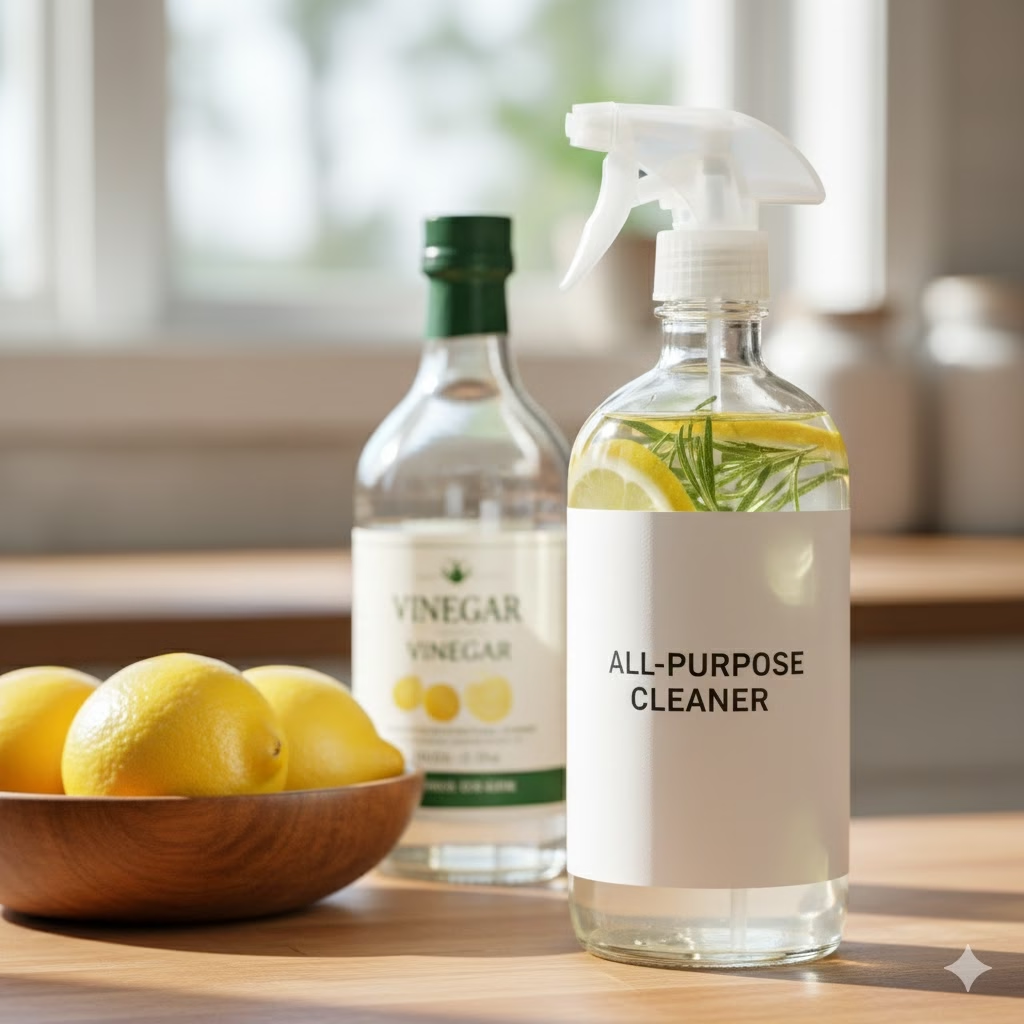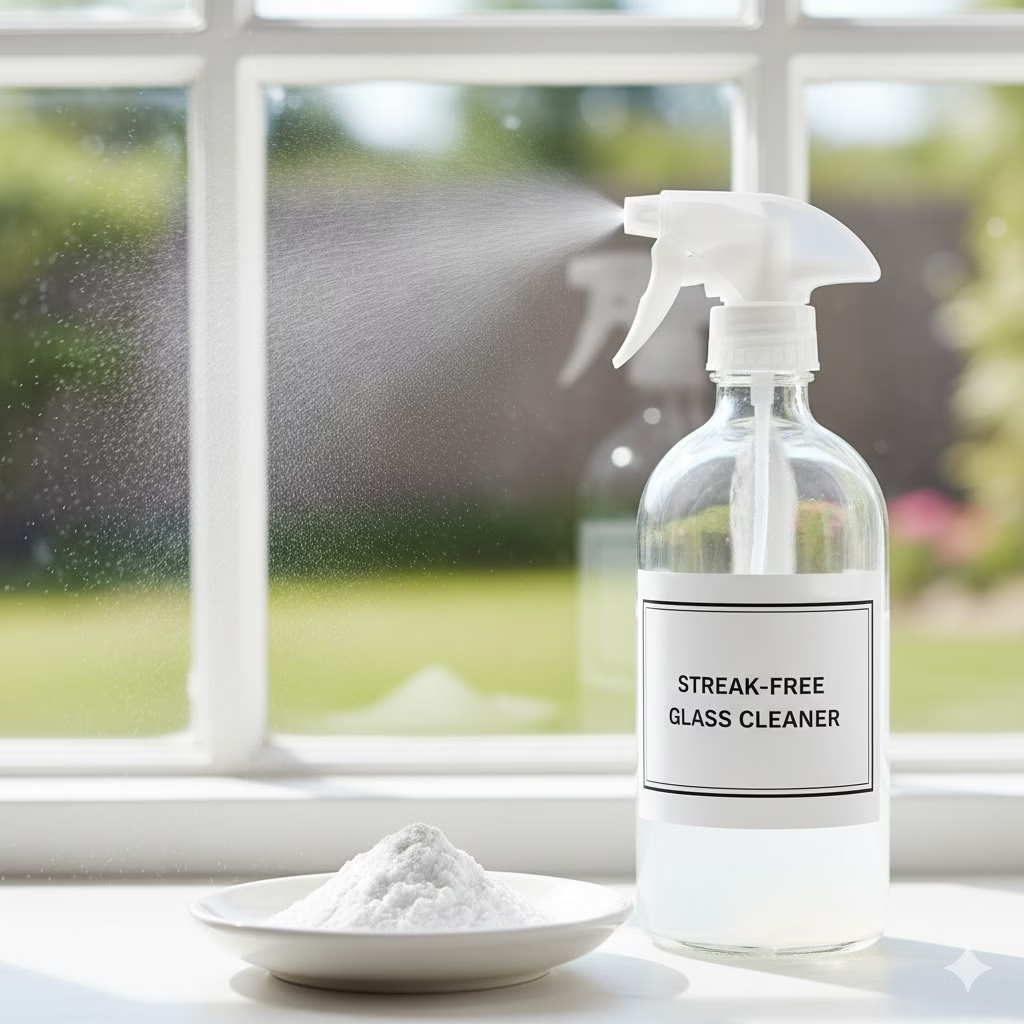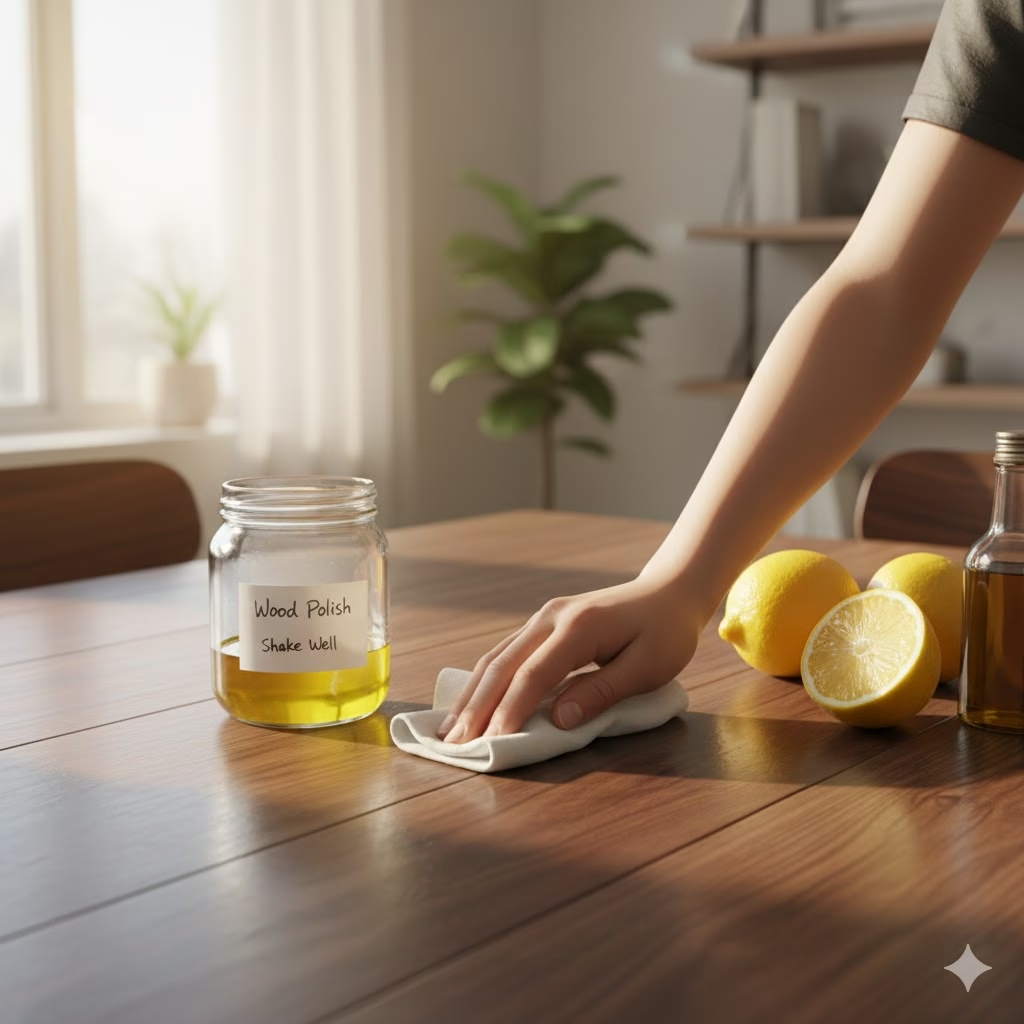
The ultimate budget hack: Transform basic Kitchen Staples into powerful, non-toxic cleaners and slash your grocery bill instantly.
Introduction: The Cleaning Kitchen Staples inside Your Pantry
Do you know what makes your store-bought, all-purpose spray work? Usually, it’s just a combination of water, a mild acid, and a lot of artificial fragrance.
The truth is, you don’t need a cabinet overflowing with expensive, harsh chemicals to get a sparkling clean home. The most effective, non-toxic, and budget-friendly cleaning solutions have been hiding in your kitchen all along. We’re talking about simple kitchen staples like vinegar, baking soda, and lemon juice.
These natural ingredients offer triple benefits: they’re incredibly cheap, they’re safe for your family and pets, and they minimize plastic waste when you reuse your own spray bottles.
This guide reveals seven simple, powerful recipes to clean every major area of your home using only the essentials you already have on hand.
I. The All-Purpose Power Spray using Kitchen Staples

This is your daily go-to for cutting light grease, eliminating germs, and wiping down sealed surfaces in the kitchen and bathroom.
| Ingredients | Ratio |
| White Vinegar (The Acid) | 1 cup |
| Water | 1 cup |
| Lemon or Orange Rinds | A handful (optional) |
Method:
- Pour the vinegar and water into a reusable glass spray bottle. Shake gently to combine.
- Optional: The Scent Infusion. To add a fresh scent and counteract the pungent vinegar smell, fill the bottle with citrus rinds (lemon, orange, or grapefruit) or a few sprigs of hearty herbs like rosemary. Let this mixture steep for 1–2 weeks before using, then strain out the solids.
- Spray the solution directly onto countertops, sink areas, cabinet fronts, and appliance exteriors. Wipe clean with a microfiber cloth.
Why It Works: White vinegar contains acetic acid, which is a powerful solvent that breaks down dirt, soap scum, and light bacterial buildup. The 1:1 dilution is strong enough to clean effectively without being too harsh on surfaces.
Pro Tip: Do not use vinegar on natural stone surfaces like granite, marble, or unsealed grout, as the acid will chemically etch and dull the finish. Use a mild soap and water solution for these areas instead.
II. Kitchen Staples for: No-Scrub Overnight Oven Paste (Baked-On Grime)

Cleaning a greasy oven is a notorious chore, but this simple paste breaks down heavy, baked-on food while you sleep, requiring only minimal scrubbing later.
| Ingredients | Ratio |
| Baking Soda (The Scourer) | 21 cup (or more) |
| Water | ∼3 Tbsp |
| White Vinegar | In a separate spray bottle |
Method:
- Remove oven racks. In a small bowl, mix the baking soda and water until a thick, spreadable, frosting-like paste forms. Adjust water as needed.
- Using a brush or gloved hand, spread the paste all over the interior of your cold oven (avoiding heating elements). The paste will quickly turn brown as it absorbs the cooked-on grime.
- Let the paste sit and work its magic overnight (at least 12 hours).
- The next morning, wipe away the majority of the dried paste with a damp cloth or sponge.
- Spray the remaining paste residue with straight vinegar. It will begin to fizz vigorously as it neutralizes the baking soda, effectively lifting any last stubborn bits. Wipe clean until the surface is residue-free.
Why It Works: Baking soda (sodium bicarbonate) is a mild abrasive that physically scrapes grime without scratching, but it’s also a powerful alkali. Alkalinity is excellent at breaking down acidic, greasy messes from cooked foods, making the grease water-soluble and easy to wipe away.
III. Streak-Free Window & Glass Cleaner (Mirrors & Glass Tables)

If you’ve ever struggled with streaks on your windows, the secret to a flawless finish is a tiny bit of cornstarch.
| Ingredients | Ratio |
| Warm Water | 2 cups |
| White Vinegar | 41 cup |
| Cornstarch (The Anti-Streaker) | 1 Tbsp |
Method:
- Mix the ingredients together, stirring or whisking thoroughly to ensure the cornstarch is fully dissolved.
- Pour into a spray bottle. Shake well before every single use to redistribute the cornstarch, as it will settle quickly.
- Spray onto glass and wipe clean with a lint-free cloth, a microfiber towel, or even crumpled-up newspaper for a crystal-clear, streak-free shine.
Why It Works: The vinegar dissolves the film and residue on the glass. The cornstarch acts as an ultrafine, gentle abrasive that helps to absorb residue and buff the glass to perfection, preventing the annoying streaking that liquid cleaners often leave behind.
IV. Foaming Drain Declogger (Slow Sinks)
This classic reaction is a safe, effective, and chemical-free way to clear minor clogs caused by hair, soap scum, and sludge.

| Ingredients | Ratio |
| Boiling Water | A kettle full |
| Baking Soda (The Base) | 21 cup |
| White Vinegar (The Acid) | 1 cup |
Method:
- Pour the kettle of boiling water down the slow drain to help loosen initial debris and warm the pipes.
- Follow immediately with the dry baking soda. Let it sit for a minute.
- Pour the vinegar down the drain. It will start to foam and bubble vigorously as the two ingredients react.
- Cover the drain with a stopper or a rag to force the chemical reaction and resulting pressure deep into the pipe where the clog resides.
- Let it sit for 15–30 minutes, then flush generously with another round of hot tap water or boiling water.
Why It Works: Mixing baking soda (a base) with vinegar (an acid) creates a large volume of carbon dioxide gas (the fizzing). This gas builds pressure and agitation inside the pipe, physically pushing and breaking up the minor clog.
V. Hardwood & Tile Floor Refresher (All Hard Floors)

This simple, minimal-ingredient formula is perfect for cutting through dirt and foot traffic residue without leaving a dull or sticky film.
| Ingredients | Ratio |
| Hot Water | 1 gallon |
| White Vinegar | 21 cup |
| Liquid Dish Soap | 1–2 drops (no more!) |
Method:
- Combine the hot water and vinegar in your mop bucket. Add just a drop or two of mild liquid dish soap—this helps lift heavy dirt but must be minimal to avoid leaving sudsy residue.
- Before applying to the floor, ensure your mop is well-wrung out; it should be damp, not dripping. Excess water is bad for hardwood and laminate.
- Mop the floor section by section. The highly diluted vinegar ensures a fast-drying, streak-free, and clean finish.
Why It Works: Vinegar’s acidity is fantastic at dissolving mineral buildup (like hard water spots) and removing soap scum left behind by other commercial cleaners. It also provides a mild sanitizing effect, and because it evaporates quickly, it leaves no residue.
VI. Porcelain Scrubbing Powder (Toilets & Tubs)

Forget those blue scouring powders! Baking soda is a natural deodorizer and a perfect mild abrasive for porcelain and fiberglass.
| Ingredients |
| Baking Soda (The Deodorizer) |
| Salt (optional, for extra scrub) |
| White Vinegar (in a spray bottle) |
Method:
- For the toilet, simply sprinkle a generous amount of baking soda into the bowl and let it sit for 5–10 minutes to absorb odors. Scrub and flush.
- For sinks, tubs, and showers, sprinkle the baking soda onto a damp sponge or brush. Scrub the surface just as you would with commercial powder.
- For stubborn rings or soap scum, sprinkle the baking soda and then spray it liberally with vinegar. Scrub the resulting bubbly paste for enhanced cleaning action.
Why It Works: Baking soda is an alkaline substance that excels at neutralizing odors. Its crystalline structure provides the perfect mild abrasion—strong enough to lift stains and grime without scratching delicate porcelain or acrylic surfaces.
VII. Lemon-Oil Wood Furniture Polish (Cabinets & Tables)

Bring life back to your wooden furniture and cabinets with this simple, Kitchen Staples of conditioning polish.
| Ingredients | Ratio |
| Olive Oil (The Conditioner) | 43 cup |
| Lemon Juice (Fresh or Bottled) | 41 cup |
Method:
- Combine the olive oil and lemon juice in a jar and shake vigorously. Note: You must shake this mixture well before each application, as the oil and acid will separate quickly.
- Dab a small amount onto a soft, lint-free cloth.
- Rub the polish into the wood surface, always working with the wood grain.
- Use a second, clean, dry cloth to lightly buff the surface until it shines and no oily residue remains.
Why It Works: The olive oil deeply conditions and moisturizes the wood, restoring its luster and helping to minimize the appearance of small scratches. The lemon juice or acid cuts through any grime and dirt while adding a fresh, natural scent.
Conclusion: A Cleaner Home, A Greener Wallet

By relying on these seven simple recipes, you’ve replaced a dozen chemical-laden products with five cheap, non-toxic kitchen staples. You’re not only saving money but also reducing the number of volatile organic compounds (VOCs) and plastic bottles in your home.
Making the switch to natural cleaning is a simple, effective step toward a healthier household. You’ve successfully turned your pantry into the most powerful cleaning store on the block!
Important Safety Notes for Kitchen Staples
- The Golden Rule of Cleaning: NEVER mix vinegar and bleach. This combination creates highly toxic chlorine gas, which can be fatal. Do not use them in the same cleaning session.
- Spot Test: Always test a small, inconspicuous area (especially on wood, paint, or tile) when trying a new solution for the first time.
References
- University of Arkansas : Clean and Green Homemade Cleaners
- The Spruce: How to Make a Homemade Vinegar Cleaning Solution
Recent Posts


